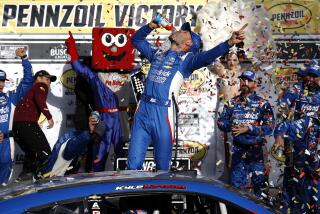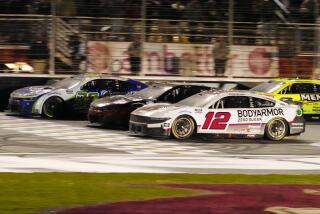NASCAR’s little engines that almost can
As the cars raced around Las Vegas Motor Speedway early this month, it was easy to spot NASCAR’s biggest names.
There was Jeff Gordon in his rainbow-colored Chevrolet sponsored by DuPont. There was Carl Edwards in his Aflac Ford and Kyle Busch in his M&M’s Toyota.
Then there was David Ragan’s No. 34 Ford with an unusual, and temporary, sponsor on the hood: Rick Santorum for President. But even a temporary sponsor is a step up from Ragan’s teammate, David Gilliland, whose No. 38 Ford was an almost bare white — without a primary sponsor decal.
Ragan, Gilliland and rookie Josh Wise drive for Front Row Motorsports, one of the small race teams trying to compete with NASCAR’s heavyweights in stock car racing’s elite Sprint Cup Series, which returns to Auto Club Speedway in Fontana on Sunday.
Front Row, with a budget one-third the size of teams such as Roush Fenway Racing and Hendrick Motorsports, and its owner Bob Jenkins must pinch pennies on testing, enter used cars, sometimes race on scuffed-up tires and vie for lesser known sponsors.
Front Row knows that Gilliland and Wise, who are from Riverside, along with Ragan have virtually no chance of winning Sunday. At the Las Vegas race, in fact, Gilliland and Wise were lapped by the leaders within the first 35 laps.
But Jenkins, a millionaire Tennessean who owns 147 franchised Taco Bell and Long John Silver’s restaurants and pays much of Front Row’s costs from his own pocket, said: “I just believe that if you’re passionate about something, then you find a way to make it work.
“It requires, sometimes, a strong stomach.”
It also sometimes requires Front Row’s drivers to become salesmen. Gilliland helped recruit an Encino-based lender, 1-800LoanMart, to be a primary sponsor on Front Row cars for five races this season, including on Gilliland’s car Sunday.
“We’ve got to do it all nowadays,” Gilliland said. “We’re definitely lean.”
How lean? While fielding a top-tier Sprint Cup car at Joe Gibbs or Hendrick costs $20 million or more a year, “each of our cars runs on a $6-million to $7-million budget,” Jenkins said.
Started in 2004, Front Row buys its engines from equipment vendor Roush Yates Engines and its cars from other teams, and “we’re pretty much left to run cars that are a year old or two years old,” Jenkins said.
Front Row has about 60 employees, and its Statesville, N.C., headquarters is about 30,000 square feet. Compare that with Hendrick — whose drivers include Gordon and five-time Cup champion Jimmie Johnson — which has 550 employees, including 47 engineers and a headquarters covering 430,000 square feet in Concord, N.C.
Owner Rick Hendrick and his drivers often fly on private jets. But Gilliland hitches a ride with Roush Yates’ crew on its airplane, and Jenkins flies commercial.
“If you love something enough, you’ll make sacrifices to do it,” Jenkins, 49, said. “Also, if I had a new Citation jet and was bouncing back and forth [on it] from the track, it’s hard for me to ask these guys to … make the sacrifice it takes.”
Those sacrifices also include skipping some tests that provide valuable data for upcoming races. “At Daytona, most of the teams went down and tested in January,” but not Front Row, Jenkins noted. “For us, that would have been a $60,000 or $70,000 proposition.”
Steve O’Donnell, NASCAR’s senior vice president of racing operations, said “we know that a Front Row doesn’t have the same capabilities as a Rick Hendrick, obviously,” so NASCAR tries to help small teams with driver appearances, social media and selling sponsorships, he said.
Front Row at times also will “start and park” in some NASCAR races. That is, a Front Row car starts a race and retire after only a few laps to collect the purse money, and points, while saving wear and tear on that car.
It’s a maneuver frowned on by NASCAR fans, but “we do it to help fund the other two [cars] so they can race” all day, Jenkins said.
Securing more sponsors would help, of course, but the tough economy has made obtaining new sponsors difficult even for the richest NASCAR teams. Sponsors pay for roughly 75% of a top team’s annual costs, but Jenkins said his sponsors cover less than 50% of his annual expenses.
“For us, it’s providing that value to a sponsor that’s not looking to spend $20 million” a year. And besides, “they’re not out there anymore,” Jenkins said. “I’d almost rather be in my situation, going after a sponsor that can spend $100,000 or $200,000 a race than to try to ask one to spend $600,000 a race.”
But that also means racing cars that are, well, rarely on the front row. Ragan and Gilliland arrive in Southern California this weekend 28th and 29th in Cup points, respectively, with Wise 43rd. None of them recorded a top-10 finish in the season’s first four races.
Jenkins is undeterred. “We’re not a team that’s competing to be in the Chase,” he said, referring to NASCAR’s 12-driver title playoff at the end of the season. “Our goal is to be a top-25 team. You’ve got to accomplish that before you can be in the Chase.”
More to Read
Go beyond the scoreboard
Get the latest on L.A.'s teams in the daily Sports Report newsletter.
You may occasionally receive promotional content from the Los Angeles Times.










